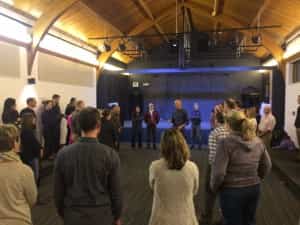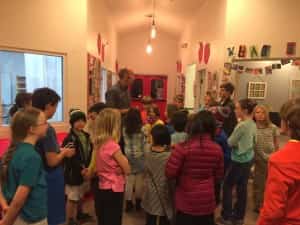“Where are the chairs?”
As participants entered the Creating Innovators Workshop last week at Mack Boulder, it was apparent from the beginning that it would be no ordinary affair with someone standing at a podium while lecturing a passive, seated audience. For over fifty adults and forty children, the workshop was a highly innovative and successful follow-up to our local screenings of the documentary Most Likely to Succeed in Boulder and Louisville last November.
The documentary took a critical look into the current state of schools today – making the case that they are designed to prepare children for the wrong future. The world that our children will inherit is changing exponentially, and schools need to shift dramatically to prepare children for their actual future. After watching Most Likely to Succeed, many in the crowd left with a natural sense of urgency to redesign schools. We promised audiences a follow up event to help them get started.
Our original idea, however, shifted radically once the workshop team of George Kembel, John Kembel, Zach Nies, and myself began the planning.
The team decided that if effective school redesign was essentially grounded by a creative and innovative mindset then Creating Innovators couldn’t just be about getting a bunch of passionate and concerned parents and students in a room to try to fix schools. The true power of the workshop would stem from empowering individuals to rediscover the power and purpose of learning – the team set out to help individuals unleash creativity and learn how to be innovators in their daily lives.
Creating Innovators wasn’t just about designing the future of school, but reimagining how learning happens everywhere—at home, in schools, and in the workplace. The premise of the workshop was that if we can all learn to be more creative and innovative in our daily lives then we will learn to become creative and effective change agents. We all want to be more innovative, but where to start?
“Innovation is not something you can be talked into. It’s something you need to experience. It’s a practice that’s learned through doing. It’s less about process and more about creative behaviors,” says George Kembel. Some of the most critical creative behaviors that should be experienced, practiced, and learned include:
- Empathy for others
- Attitude of prototyping
- Collaborating with diverse teams
- Emotional safety
- Rapidly iterating and adapting
- Bias towards action
- Showing rather than telling
- Preserving ambiguity
- Comfort with failure
- Visual thinking
In order to unleash many of the creative behaviors, the workshop was designed around three “creative postures.” The idea behind creative postures, Kembel says, is that “in a few minutes we can experience what it feels like to move in a creative way. What does it feel like to be in closed or judging mind as apposed to being in an open generative mind? What does it feel like to build on the ideas of others? Or to be open to the learning that comes when things at first don’t work?”
The first creative postures participants experienced was called Ta-da. During the activity, partners faced each other and practiced a series of counting exercises that ultimately lead to multiple quick failures. Ta-da is designed to help shift our attitudes from one where we are afraid of the consequences of failure towards one where we are open to what we might learn when things don’t go the way we expect. Nies adds, “The Ta-da exercise was about leaning into discomfort and recognizing the shame we inherently have when things don’t go as expected and the degree to which fearing failure contributes to our failure.” Eventually most partners digressed into fits of laughter and encouragement (demonstrated in the form of an audible “Ta-da!” with hands in the air in celebration of failure). Nies adds, “With the simple change of celebrating those moments we can push through them.”
The second creative posture was called Party, Park, Jail. The premise of this three part exercise was to experience what it feels like to create emotional safety in a group where everyone can be themselves, share what they notice, and contribute ideas freely. Teams that seek to be innovative and collaborative have to be able to have the honest conversations necessary to navigate the dynamics of creative work. To Nies, this posture demonstrated “the role that human connection plays in enabling collaboration.”
The third and final creative posture was Ball Toss, where teams of adults and children worked together to move tennis balls from one bucket to another, each attempt trying to beat their overall time. The ball toss demonstrated the power of iteration as teams typically got 2x better with each try. Nies adds, “When teams spent all their time planning there was little correlation to time spent planning and the overall effectiveness of the group.” With the Ball Toss activity, teams got to experience the difference between directed work and the adaptability of self-directed teams. “Too often we bias towards planning or prescribing how work happens. For creative work to emerge, it’s important for innovators and kids to have the agency to get started and adapt as they go to discover the most innovative approaches and outcomes,” says Kembel.
The overarching themes that emerged from Creating Innovators that were immediately useful to participants as they take steps towards redesigning schools were: building empathy with end users (students), creating the context to enable innovation to flourish, and focusing on effective framing of problems rather than focusing solely on solutions. We also learned that innovative behaviors are difficult to learn by passive reading or watching—you have to experience them to learn.
The Creating Innovators debrief revealed a strong desire for a series of workshops that would allow participants to begin applying what they learned towards the settings of home, school, and work. The first in the series, Creating Innovation at Home, will take place on Monday, February 29th from 6:30-8:00pm at the Mack-Boulder campus. This workshop will again feature George Kembel, John Kembel, and Zack Nies who will inspire participants to develop an innovator’s mindset and design solutions to everyday struggles in their home lives. Bring your common frustrations and leave with a new title of “family hero!”
Again, the chairs will be conspicuously absent.
~JJ Morrow, Mack parent and Head of School of Mackintosh Academy-Boulder
About the Leaders: George Kembel is a Mack parent, a Co-Founder of Stanford’s D.School, and D.Global; John Kembel is a Mack parent, a serial entrepreneur, and a Co-Founder of D.Global; Zach Nies is the Managing Director of Techstars.
